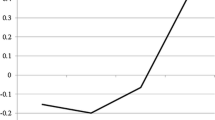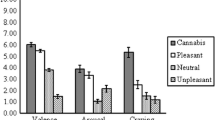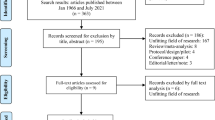Abstract
Studies that have investigated the effect of motivation to change on the startle reflex have been limited to comparisons among smokers with low and high motivation, but differences in the startle reflex throughout all stages of change have not been studied. Therefore, the aim of the present study was to identify differences in the startle reflex in response to tobacco-related cues in smokers in the initial, intermediate, and final stages of change. The startle reflex was recorded in 67 smokers and ex-smokers while they viewed pleasant, neutral, unpleasant, and tobacco-related pictures. The results showed that the pattern of the startle reflex in response to tobacco-related pictures varied according to the motivation to change. In smokers in the initial stages, the magnitude of the startle reflex was similar between tobacco-related pictures and pleasant pictures. In smokers in intermediate stages, the magnitude of the startle reflex was similar between tobacco-related pictures and unpleasant pictures. In ex-smokers in the final stages, the magnitude of the startle reflex was similar between tobacco-related pictures and neutral pictures. These results suggest that motivational systems that are activated by tobacco-related cues vary according to smokers’ motivation to change.

Similar content being viewed by others
Notes
IAPS codes for pictures: pleasant (4676, 4693, 4668, 4692, 4698, 4623, 4677), neutral (7026, 7161, 7179, 7013, 7018, 7041, 7021), unpleasant (1525, 1932, 6315, 6520, 9163, 3213, 2683).
References
Blumenthal, T. D., Cuthbert, B. N., Filion, D. L., Hackley, S., Lipp, O. V., & van Boxtel, A. (2005). Committee report: Guidelines for human startle eyeblink electromyographic studies. Psychophysiology, 42, 1–15.
Bradley, M. (2009). Natural selective attention: Orienting and emotion. Psychophysiology, 46, 1–11. doi:10.1111/j.1469-8986.2008.00702.x.
Bradley, M., Codispoti, M., Cuthbert, B., & Lang, P. J. (2001). Emotion and motivation I: Defensive and appetitive reactions in picture processing. Emotion, 1(3), 276–298. doi:10.1037//1528-3542.1.3.276.
Bradley, M., & Lang, P. (2007). Emotion and motivation. In J. Cacioppo, L. Tassinary, & G. Berntson (Eds.), The Handbook of Psychophysiology. New York: Cambridge University Press.
Cinciripini, P. M., Robinson, J. D., Carter, B. L., Lam, C., Wu, X., de Moor, C. A., et al. (2006). The effects of smoking deprivation and nicotine administration on emotional reactivity. Nicotine and Tobacco Research, 8, 379–392.
Cui, Y., Robinson, J., Versace, F., Lam, C., Minnix, J., Karam-Hage, M., et al. (2012). Differential cigarette-related startle cue reactivity among light, moderate, and heavy smokers. Addictive Behaviors, 37, 885–889. doi:10.1016/j.addbeh.2012.02.003.
Dempsey, J. P., Cohen, L. M., Hobson, V. L., & Randall, P. K. (2007). Appetitive nature of drug cues re-confirmed with physiological measures and the potential role of stage of change. Psychopharmacology (Berl), 194, 253–260.
DiClemente, C. C., Prochaska, J. O., Fairhurst, S., Velicer, W. F., Rossi, J. S., & Velasquez, M. (1991). The process of smoking cessation: An analysis of precontemplation, contemplation and contemplation/action. Journal of Consulting and Clinical Psychology, 59, 295–304.
Diemert, L. M., Bondy, S. J., Brown, K. S., & Manske, S. (2013). Young adult smoking cessation: Predictors of quit attempts and abstinence. American Journal of Public Health, 103(3), doi: 10.2105/AJPH.2012.300878.
Gantiva, C., Díaz, D., Ospina, I., Gutierrez, A., & Romo-Gonzalez, T. (2014). Modulation of the startle response in verbal aggressors: differences among stimuli with distinct affective social content. Psychology and Neuroscience, 7(2), 221–225. doi:10.3922/j.psns.2014.016.
Gantiva, C., Guerra, P., & Vila, J. (2011). Validación colombiana del sistema internacional de imágenes afectivas: evidencias del origen transcultural de la emoción. Acta Colombiana de Psicología, 14(2), 103–111.
Gantiva, C., Rodríguez, M., Arias, M., & Rubio, E. (2012a). Dimensiones de la emoción durante el proceso de abandono del consumo de tabaco: Un apoyo a la visión motivacional del cambio. Diversitas: Perspectivas en Psicología, 8(2), 309–317.
Gantiva, C., Rodríguez, M., Arias, M., Rubio, E., Guerra, P., & Vila, J. (2012b). Diseño y validación de un sistema de imágenes afectivas relacionadas con el consumo de tabaco en población colombiana. Pensamiento Psicológico, 10(2), 113–122.
Glautier, S., & Tiffany, S. T. (1995). Methodological issues in cue reactivity research. In D. C. Drummond, S. T. Tiffany, S. P. Glautier, & B. Remington (Eds.), Addictive behaviour: cue exposure, theory and practice (pp. 75–98). Chichester: Wiley.
Lang, P. J. (1995). The emotion probe: Studies of motivation and attention. American Psychologist, 50, 372–385.
Lang, P. J. (2010). Emotion and motivation: Toward consensus definitions and a common research purpose. Emotion Review, 2(3), 229–233. doi:10.1177/1754073910361984.
Lang, P., Bradley, M., & Cuthbert, B. (2008). International affective picture system (IAPS): Affective ratings of pictures and instruction manual. Technical Report A-8. Gainesville, FL: University of Florida.
Mann-Wrobel, M., Bennett, M., Weiner, E., Buchanan, R., & Ball, M. (2011). Smoking history and motivation to quit in smokers with schizophrenia in a smoking cessation program. Schizophrenia Research, 126, 277–283. doi:10.1016/j.schres.2010.10.030.
McBride, D., Barrett, S. P., Kelly, J. T., Aw, A., & Dagher, A. (2006). Effects of expectancy and abstinence on the neural response to smoking cues in cigarette smokers: An fMRI study. Neuropsychopharmacology, 31, 2728–2738.
McClernon, F. J., Hiott, F. B., Huettel, S. A., & Rose, J. E. (2005). Abstinence-induced changes in self-report craving correlate with event-related FMRI responses to smoking cues. Neuropsychopharmacology, 30, 1940–1947.
McClernon, F. J., Kozink, R. V., Lutz, A. M., & Rose, J. E. (2009). 24-h smoking abstinence potentiates fMRI-BOLD activation to smoking cues in cerebral cortex and dorsal striatum. Psychopharmacology (Berl), 204, 25–35.
Muñoz, M., Idrissi, S., Sánchez-Barrera, M., Fernández, M., & Vila, J. (2011). Motivation to quit smoking and startle modulation in female smokers: context specificity of smoking cue reactivity. Psychopharmacology (Berl), 218, 525–532. doi:10.1007/s00213-011-2334-0.
Prochaska, J. O., DiClemente, C. C., & Norcross, J. C. (1992). In search of how people change. Applications to addictive behaviors. The American Psychologist, 47(9), 1102–1114.
Prochaska, J., & Norcross, J. (2001). Stages of change. Psychotherapy, 38(4), 443–448.
Ramo, D., Delucchi, K., Liu, H., Hall, S., & Prochaska, J. (2014). Young adults who smoke cigarettes and marijuana: Analysis of thoughts and behaviors. Addictive Behaviors, 39(1), 77–84. doi:10.1016/j.addbeh.2013.08.035.
Rehme, A. K., Frommann, I., Peters, S., Block, V., Bludau, J., Quednow, B. B., et al. (2009). Startle cue-reactivity differentiates between light and heavy smokers. Addiction, 104(10), 1757–1764.
Smit, E., Hoving, C., Schelleman-Offermans, K., West, R., & de Vries, H. (2014). Predictors of successful and unsuccessful quit attempts among smokers motivated to quit. Addictive Behaviors, 39, 1318–1324. doi:10.1016/j.addbeh.2014.04.017.
Vangeli, E., Stapleton, J., Smit, E., Borland, R., & West, R. (2011). Predictors of attempts to stop smoking and their success in adult general population samples: A systematic review. Addiction, 106(12), 2110–2121. doi:10.1111/j.1360-0443.2011.03565.x.
Velicer, W. F., Fava, J. L., Prochaska, J. O., Abrams, D. B., Emmons, K. M., & Pierce, J. (1995). Distribution of smokers by stage in three representative samples. Preventive Medicine, 24, 401–411.
Acknowledgments
The present research was supported by Grant from Santander Bank for Latin-American young professors and researchers (JPI).
Author information
Authors and Affiliations
Corresponding author
Rights and permissions
About this article
Cite this article
Gantiva, C., Ballén, Y., Casas, M. et al. Influence of motivation to quit smoking on the startle reflex: differences between smokers in different stages of change. Motiv Emot 39, 293–298 (2015). https://doi.org/10.1007/s11031-014-9449-7
Published:
Issue Date:
DOI: https://doi.org/10.1007/s11031-014-9449-7




